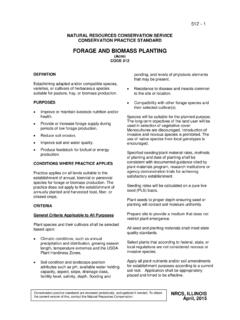Transcription of Natural Resources Conservation Service Plant Guide
1 PROSO MILLET Panicum miliaceum L. Plant Symbol = PAMI2 Photograph of Dove proso millet. Photo by USDA-NRCS Jimmy Carter Plant Materials Center, hosted by the USDA-NRCS PLANTS Database. Alternate Names Common Names: broomcorn millet, proso, wild millet, black seeded proso millet, panic millet, broom corn, hog millet, common millet Scientific Names: Panicum miliaceum var. aureum Alef.; Panicum miliaceum var. flavum Schur; Panicum miliaceum var. sanguineum Alef. Description General: Proso millet (Panicum miliaceum) is an introduced, warm-season annual grass that grows 1 3 ft tall. Stems are light green, erect, sometimes branched at the base, and grow 20 60 in ( m) tall. Leaves alternate along the stem and are covered with short, stiff hairs. The wide-spreading or arching leaves may reach approximately 1 ft (30 cm) long, have a short ligule (outgrowth at junction of grass leaf and blade) and no auricles (ear-like appendage at the base of leaf) (Baltensperger, 1996).
2 Plants have shallow, fibrous root systems and produce few tillers. Proso millet has a drooping, branched, compact inflorescence 4 18 in (10 45 cm) long made of many stalked, ovoid spikelets. The panicles may be spreading, loose and one-sided, or erect depending on the variety (McDonald et al., 2003). Proso millet reproduces by seeds, which are shiny, yellow to brown, smooth, oval and in ( 3 mm) long. There is both a weedy wild-proso millet and a domesticated proso millet. Domestic proso millet has yellow or light brown seeds, while the weedier wild-proso has brown to black seeds. Proso millet can be easily confused with young corn seedlings, fall panicum (Panicum dichotomiflorum), and witch grass (Panicum capillare). A distinguishing feature of the Plant is that the seed husk (palea and lemma) remains attached to the roots of seedlings (Bough et al.)
3 , 1986). Distribution: It is thought that proso millet was originally cultivated in eastern Asia, later spreading to India, Russia, the Middle East, and Europe (Baltensperger, 1996). Today proso millet is produced in India, China, Russia, the Middle East (Baltensperger, 1996). In the United States, it is mainly grown in the Great Plains states of Nebraska, South Dakota, and Colorado, with limited production in Kansas, Wyoming, and Minnesota. US production has increased in the past 10 years (McDonald et al., 2003). The weedier wild-proso millet is thought to have escaped from domesticated varieties, and can be found throughout the United States. For current distribution, please consult the Plant Profile page for this species on the PLANTS Web site. Habitat: Proso millet grows best in full sun, moist to dry conditions, and can perform well in many soil types.
4 It is found in croplands, fallow fields, roadsides, waste sites, and disturbed soils. Adaptation Proso millet has been grown for thousands of years in many types of soils and in many climates. It is both heat and drought-tolerant and is widely grown in the tropics and sub-tropics. Proso millet is a C4 Plant with a low transpiration ratio; its high water use efficiency allows it to grow in water-limited environments (Baltensperger, 1996; Lyon et al., 2008). It can be grown farther north than other millets and is adapted to high elevation plateaus and poor soil (Baltensperger, 1996). However, due to its shallow root system, it does not grow well under water stress (Baltensperger, 1996). It is not frost-tolerant and does not grow well in soils with a pH greater than It has poor tolerance to high salinity. Uses Forage/Feed: Similar to several other millets, proso millet is grown for livestock and birdseed in the United States.
5 Substituting proso millet for half the food ration for cattle and swine is considered similar to using sorghum or corn (Baltensperger, 1996; Lyon et al., 2008). Turkeys gained more weight on a diet of proso millet than on corn or sorghum, however broiler chickens did not significantly gain more weight (Baltensperger, 1996). Proso millet fed to swine and poultry should be supplemented with lysine (Lyon et al., 2008). Natural Resources Conservation Service Plant Guide Cover crop/green manure: Proso millet can be used as a quick growing catch crop planted into corn and sorghum stubble fields. It does well planted in combination with cowpea or soybeans (Schonbeck and Morse, 2006). It has one of the lowest water requirements of any cereal (Baltensperger, 1996; Lyon et al., 2008), and could be useful in low-input sustainable systems.
6 Earlier summer (June) plantings produce the greatest biomass (Schonbeck and Morse, 2006). It can be terminated by mowing or disking. Winter wheat has been successfully no-till planted into proso millet stubble in the fall in the Great Plains (Lyon et al., 2008). Filter Strips/Field Borders: Proso millet has been used in mixes for herbaceous Conservation buffers/filter strips in USDA Wildlife Habitat Incentives Program (WHIP) applications (USDA-NRCS, 2009). Wildlife: Proso millet seed is eaten by bobwhite quail, mourning doves, pheasants, turkeys, and a variety of songbirds. It is also the host Plant for several genera of skipper (Hilty, 2014). Ethnobotany Proso millet contains greater protein and iron than wheat or rice (Millet Network of India et al., 2009). It was one of the earliest domesticated cereals and is still widely used for human consumption in India, the Middle East, China, and parts of Russia (Bough et al.)
7 , 1986). Status Weedy or Invasive: Wild-proso millet is the escaped form of the cultivated proso millet, and can be weedy or invasive throughout the United States. It is considered a noxious weed in Colorado and Oregon. It is a rapidly growing, vigorous, prolific seed producer that has developed some herbicide resistance. Please consult with your local NRCS Field Office, Cooperative Extension Service office, state Natural resource , or state agriculture department regarding its status and use. Please consult the PLANTS Web site ( ) and your State Department of Natural Resources for this Plant s current status ( , threatened or endangered species, state noxious status, and wetland indicator values). Planting Guidelines Proso millet will germinate between 50 113 F (10 45 C) (Baltensperger, 1996). The optimum soil temperature for planting is 55 65 F (13-18 C) (McDonald et al.
8 , 2003). It is typically drilled at 30 40 lb/ac for forage or feed, inches deep, on 7, 10, or 12 inch rows (McDonald, 2003). A lower rate of 20 lb/ac can be used for producing seed (Baltensperger et al., 1995). It is planted as a warm-season cover crop in the Great Plains in late May to early June (Lyon et al., 2008). It has been successfully grown as a dryland crop with little or no supplemental irrigation. It is used in rotation with winter wheat and can help to reduce disease and insect pressure (Lyon et al., 2008). Planting after winter wheat may lead to N deficiency, so fertilizer applications of nitrogen and additional nutrients may be required. Fertilizer additions should be based on soil test results and the recommendations of the local county extension Service . Management Proso millet does not seem to benefit from high-input additions of nutrients or water (Baltensperger, 1996).
9 Like foxtail millet (Setaria italica), there will be little regrowth after being cut (Baltensperger, 1996). Proso millet has been used in a winter wheat/sunflower/proso/fallow rotation in the Great Plains (Lyon et al., 2008). In September it is cut and gathered into windrows to dry and cure. Proso millet is not direct-combined because the seed shatters easily, the straw moisture is too high at harvest, and it tends to lodge (McDonald et al., 2003). Pests and Potential Problems There are few if any disease or insect problems. European corn borer moths will lay eggs on millet, and thrips and grasshoppers will occasionally feed on it (McDonald et al., 2003). In order to reduce weed pressure, wheat proso millet rotations should not be continued past three consecutive years. Environmental Concerns Weedy biotypes of proso millet can produce a long-term seed bank.
10 Nevertheless, proso millet varieties used as crops have little ability to survive dormancy or maintain viable seed banks (Bough et al., 1986). Rotations are one way of avoiding weedy characteristics. Seeds and Plant Production Proso millet matures 60 90 days after planting. Seeds mature from the top of the inflorescence to the bottom, and may shatter before harvesting (Baltensperger, 1996). Proso millet is self-pollinating, but some cross-pollination may occur by the wind (Baltensperger, 1996). Plants remain in bloom for only a week (Hilty, 2014). Seeds are smaller (80,000 seed/lb) than pearl millet and may be white, cream, yellow, orange, red, or black to brown. It can produce 2,000 lb/ac of seed (NRCS, 2012). Cultivars, Improved, and Selected Materials (and area of origin) Dove proso millet is a cultivar developed by the USDA-NRCS Plant Materials Center in Americus, GA in 1972.


















